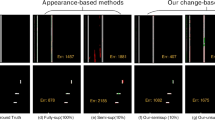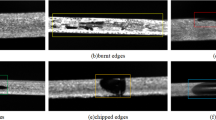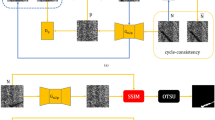Abstract
Defect detection of photovoltaic (PV) glass products is a challenge due to its complex optical properties and lack of defective samples. Aiming at this problem, a multi-task framework, in which an auxiliary semantic segmentation task based on the generative adversarial network assists the main defective classification task, is proposed. The auxiliary task guides the feature extractor to focus on the contour of the glass. Level set map (LSM), a new representation of contour which is the integration of a mask, is introduced into the framework to further improve the performance. Unlike level set loss, which is an indirect contour constraint on the segmentation loss in the form of a regular term, LSM is a direct annotation parallel with mask. Recovering LSM and mask simultaneously can affect each other positively. Two synthetic PV glass datasets, named SynSmall and SynBig, and two real-world PV glass datasets, named Mask3 and Defect3, are established to validate the proposed method. Two groups of experiments on the glass datasets are designed to inspect the feasibility and performance of the proposed framework from different aspects. Furthermore, a group of experiments involving separate segmentation tasks on SynSmall and Mask3, together with two public datasets TOMNet and Human, are executed to illustrate the performance of LSM. Experimental results show that the proposed framework can improve the accuracy of PV glass defective detection task significantly and LSM can improve the segmentation accuracy by filtering isolated wrongly recovered regions.



















Similar content being viewed by others
Explore related subjects
Discover the latest articles, news and stories from top researchers in related subjects.References
Yang X, Pang G, Yung N (2005) Robust fabric defect detection and classification using multiple adaptive wavelets. Vis Image Signal Process 152:715–723
Lin S, He Z, Sun L (2019) Defect enhancement generative adversarial network for enlarging data set of microcrack defect. IEEE Access 7:148413–148423
Liu K, Li A, Wen X, Chen H, Yang P (2019) Steel surface defect detection using GAN and one-class classifier. In: International conference on automation and computing, pp 5–7. Chinese Automation and Computing Society in the UK - CACSUK
Lian J, Jia W, Zareapoor M, Zheng Y, Luo R (2020) Deep-learning-based small surface defect detection via an exaggerated local variation-based generative adversarial network. IEEE Trans Ind Inf 16(2):1343–1351
Bing H, Wang J (2020) Detection of PCB surface defects with improved faster-RCNN and feature pyramid network. IEEE Access 8:108335–108345
Feng Y, Chen Z, Wang D, Chen J, Feng Z (2020) DeepWelding: a deep learning enhanced approach to GTAW using multisource sensing images. IEEE Trans Ind Inf 16(1):465–474
Ming W, Shen F, Li X, Zhang Z, Jinguang D, Chen Z, Cao Y (2020) A comprehensive review of defect detection in 3C glass components. Measurement 158(1):1–20
Zhang C, Chen X, Yunjie X, Wei Z, Zhou S (2020) Surface defect detection system of glass. Packag Eng 41(13):216–222
Jian C, Gao J, Ao Y (2017) Automatic surface defect detection for mobile phone screen glass based on machine vision. Appl Soft Comput J 52(3):348–358
Wang C, Huang Y, Zhang X, Shenglin L (2020) A Method of scratch defects detection for curved glass based on machine vision. Tech Autom Appl 39(1):134–139
Zhou X, Wang Y, Zhu Q, Mao J, Xiao C, Xiao L, Zhang H (2020) A surface defect detection framework for glass bottle bottom using visual attention model and wavelet transform. IEEE Trans Ind Inf 16(4):2189–2201
Yao HB, Ping J, Ma GD, Li LW, Gu JN (2013) The system research on automatic defect detection of glasses. Appl Mech Mater 437:362–365
Rosli NS, Fauadi MHFM, Awang NF, Noor AZM (2018) Vision-based defects detection for glass production based on improved image processing method. J Adv Manuf Technol 12(203–212):1–224
Xiong H, Fan C, Zhao S, Ying Yu (2020) Glass surface defect detection method based on multiscale convolution neural network. Comput Integr Manuf Syst 26(4):900–909
Zhang J, Su H, Zou W, Gong X, Zhang Z, Shen F (2020) CADN: a weakly supervised learning-based category-aware object detection network for surface defect detection. Pattern Recognit 109:107571
He K, Zhang X, Ren S, Sun J (2016) Deep residual learning for image recognition. In: Proceedings of the IEEE international conference on computer vision, pp 770–778
Tan M, Le QV (2019) EfficientNet: Rethinking model scaling for convolutional neural networks. arXiv:1905.11946, pp 1–10
Poudel RPK, Liwicki S, Cipolla R (2019) Fast-SCNN: fast semantic segmentation network. arXiv:1902.04502, pp 1–17
He K, Gkioxari G, Dollar P, Girshick R (2017) Mask R-CNN. In: Proceedings of the IEEE international conference on computer vision, pp 2961–2969
Ren S, He K, Girshick R, Jian S (2015) Faster R-CNN: towards real-time object detection with region proposal networks. IEEE Trans Pattern Anal Mach Intell 39(6):1137–1149
Yang Z, Xie X, Zhan Q, Liu G, Cai Q (2019) A neural-network-based framework for cigarette laser code and identification. Neural Comput Appl 32(15):11597–11606
Bochkovskiy A, Wang CY, Mark Liao HY (2020). YOLOv4: optimal speed and accuracy of object detection. arXiv: 2004.10934v1, pp 1–17
Kirillov A, He K, Girshick R, Rother C, Dollar P (2019) Panoptic segmentation. In: IEEE conference on computer vision and pattern recognition, pp 9396–9405
Isola P, Zhu JY, Zhou T, Efros AA (2017). Image-to-image translation with conditional adversarial networks. In: IEEE international conference on computer vision, pp 5967–5976
Kim Y, Kim S, Kim T, Kim C (2019) CNN-based semantic segmentation using level set loss. In: 2019 IEEE winter conference on applications of computer vision (WACV), pp 1752–1760
Peng S, Jiang W, Pi H, Li X, Bao H, Zhou X (2020) Deep snake for real-time instance segmentation. arXiv:2001.01629, pp 1–10
Chen G, Han K, Wong KKY (2018) TOM-Net: learning transparent object matting from a single image. In: 2018 IEEE/CVF conference on computer vision and pattern recognition, pp 9233–9241
Liang Y, Huang H, Cai Z, Hao Z, Feng F (2020) Survey of natural image matting. Appl Res Comput 38(5):1–10
Goodfellow IJ, Pouget-abadie J, Mirza M, Xu B, Warde-farley D (2014) Generative adversarial nets. arXiv: 1406.2661v1, pp 1–9
Mirza M, Osindero S (2014) Conditional generative adversarial nets.pdf. arXiv: 1411.1784v1, pp 1–7
Odena A, Olah C, Shlens J (2017) Conditional image synthesis with auxiliary classifier gans. In: International conference on machine learning, ICML 2017, vol 6, pp 4043–4055
Arjovsky M, Chintala S, Bottou L (2017) Wasserstein GAN. arXiv: 1701.07875v3, pp 1–32
Gulrajani I, Ahmed F, Arjovsky M, Dumoulin V, Courville A (2017) Improved training of Wasserstein GANs.pdf. arXiv: 1704.00028v3, pp 1–20
Creswell A, White T, Dumoulin V, Arulkumaran K, Sengupta B, Bharath AA (2018) Generative adversarial networks: an overview. IEEE Signal Process Mag 35(1):53–65
Hong Y, Hwang U, Yoo J, Yoon S (2019) How generative adversarial networks and their variants work: an overview. ACM Comput Surv 52(1):1–41
Ronneberger O, Fischer P, Brox T (2015) U-net: convolutional networks for biomedical image segmentation. arXiv: 1505.04597, pp 1–8
Wang T, Liu M, Zhu J, Liu G, Tao A, Kautz J, Catanzaro B (2018) Video-to-video synthesis. arXiv: 1808.06601v2, pp 1–14
Wang TC, Liu MY, Zhu JY, Tao A, Kautz J, Catanzaro B (2018) High-resolution image synthesis and semantic manipulation with conditional GANs. In: IEEE international conference on computer vision, pp 8798–8807
Zhu JY, Park T, Isola P, Efros AA (2017). Unpaired image-to-image translation using cycle-consistent adversarial networks. In: IEEE international conference on computer vision, pp 2242–2251
Yi Z, Zhang H, Tan P, Gong M (2017) DualGAN: unsupervised dual learning for image-to-image translation. In: IEEE international conference on computer vision, pp 2868–2876
Kim T, Cha M, Kim H, Kwon J, Jiwon L (2017) Learning to discover cross-domain relations with generative adversarial networks. arXiv: 1703.05192, pp 1–10
Li B, Yuan X, Shi M (2020) Synthetic data generation based on local-foreground generative adversarial networks for surface defect detection. J Electron Imaging 29(1):1–14
Xinyi L, Junhui M, Haodong Z, Boyu Z, Juntong X (2020) A learning-based approach for surface defect detection using small image datasets. Neurocomputing 408:112–120
Liu J, Wang C, Hai S, Bo D, Tao D (2020) Multistage GAN for fabric defect detection. IEEE Trans Image Process 29:3388–3400
Lyu Y, Han Z, Zhong J, Li C, Liu Z (2020) A generic anomaly detection of catenary support components based on generative adversarial networks. IEEE Trans Instrum Meas 69(5):2439–2448
Wang J, Li X, Yang J (2018) Stacked conditional generative adversarial networks for jointly learning shadow detection and shadow removal. In: IEEE international conference on computer vision, pp 1788–1797
Bolya D, Zhou C, Xiao F, Lee Y J (2019) YOLACT: Real-time instance segmentation. arXiv:1904.02689, pp 1–12
Acknowledgements
This work is supported by National Natural Science Foundation of China (62002053), Natural Science Foundation of Guangdong Province (2021A1515011866), Guangdong Basic and Applied Basic Research Projects (2019A1515111082), Social Welfare Major Project of Zhongshan (2019B2010, 2019B2011, 420S36), Achievement Cultivation Project of Zhongshan Industrial Technology Research Institute (419N26), Science and Technology Foundation of Guangdong Province (2021A0101180005), and Young Innovative Talents Project of Education Department of Guangdong Province (2018KQNCX337, 2019KQNCX186).
Author information
Authors and Affiliations
Corresponding author
Ethics declarations
Conflict of interest
The authors declare that they have no competing interests.
Additional information
Publisher's Note
Springer Nature remains neutral with regard to jurisdictional claims in published maps and institutional affiliations.
Rights and permissions
About this article
Cite this article
Dong, S., Chen, C., Liang, Y. et al. Defect detection of photovoltaic glass based on level set map. Neural Comput & Applic 34, 10691–10705 (2022). https://doi.org/10.1007/s00521-022-07005-x
Received:
Accepted:
Published:
Issue Date:
DOI: https://doi.org/10.1007/s00521-022-07005-x




